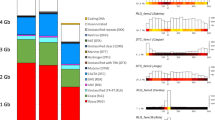Abstract
Statistical analysis of the distribution of transposable elements (TEs) and tRNA genes in the genome of yeast Saccharomyces cerevisiae indicated that, although tRNA genes and other genes transcribed by RNA polymerase III are targets for TE insertion, the distribution of TEs was significantly more clumped than that of tRNAs. Genomic blocks putatively duplicated as the result of an ancient polyploidization event contained fewer TEs than expected by their length, and nearly two thirds of duplicated blocks lacked TEs altogether. In addition, the edges of duplicated blocks tended to be located in TE-poor genomic regions. These results can be explained by the hypotheses: (1) that transposition events have occurred well after block duplication; (2) that TEs have frequently played a role in genomic rearrangement events in yeast. According to this model, duplicated blocks identifiable as such in the present-day yeast genome are found largely in regions with low TE density because in such regions the duplicated structure has not been obscured by TE-mediated rearrangements.
Similar content being viewed by others
References
Bennetzen, J.L., 2000. Transposable element contributions to plant gene and genome evolution. Plant Mol. Biol. 42: 251–269.
Blanc, G., K. Hokamp & K.H. Wolfe, 2003. A recent polyploidy superimposed on older large-scale duplications in the Arabidopsis genome. Genome Res. 13: 137–144.
Daboussi, M.J., 1997. Fungal transposable elements and genome evolution. Genetica 100: 253–260.
Devine, S.E. & J.D. Boeke, 1996. Regionally specific, targeted integration of the yeast retrotransposon Ty1 upstream of genes transcribed by RNA polymerase III. Genes Dev. 10: 620–633.
Federoff, N. 2000. Transposons and genome evolution in plants. Proc. Natl. Acad. Sci. USA 97: 7002–7009.
Friedman, R. & A.L. Hughes, 2001. Gene duplication and the structure of eukaryotic genomes. Genome Res. 11: 373–381.
Hughes, A.L. & R. Friedman, 2003. Parallel evolution by gene duplication in the genomes of two unicellular fungi. Genome Res. 13: 794–799.
Hughes, A.L., R. Friedman, V. Ekollu & J.R. Rose, 2003. Non-random associations of transposable elements with duplicated genomic blocks in Arabidopsis thaliana. Mol. Phyl. Evol. 29: 410–416.
Kidwell, M.G. & D.R. Lisch, 2001. Perspective: transposable elements, parasitic DNA, and genome evolution. Evolution 55: 1–24.
Kim, J.M., S. Vanguri, J.D. Boeke, A. Gabriel & D.F. Voytas, 1998. Transposable elements and genome organization: a comprehensive survey of retrotransposons revealed by the complete Saccharomyces cerevisiae genome sequence. Genome Res. 8: 464–478.
McDonald, J.F. 1993. Evolution and consequences of transposable elements. Curr. Opin. Genet. Dev. 3: 855–864.
Pinsker, W., E. Haring, S. Hagemann & W.J. Miller, 2001. The evolutionary history of P transposons: from horizontal invaders to domesticated neogenes. Chromosoma 110: 148–158.
Promislow, D.E.L., I.K. Jordan & J.F. McDonald, 1999. Genomic demography: a life-history analysis of transposable element evolution. Proc. R. Soc. Lond. B 266: 1555–1560.
Rothnie, H.M., K.J. McCurrach, L.A. Glover & N. Hardman, 1991. Retroposon-like nature of Tp1 elements: implications for the organization of highly repetitive, hypermethylated DNA in the genome of Physarum polycephalum. Nucleic Acids Res. 19: 279–286.
San Miguel, P., A. Tikhonov, Y.K. Jin, N. Motchoulskaia, D. Zakharov, A. Melake-Berhan, P.S. Springer, K.J. Edwards, M. Lee, Z. Avramova & J.L. Bennetzen, 1996. Nested retrotrans-posons in the intergenic regions of the maize genome. Science 274: 765–768.
Seoighe, C. & K.H. Wolfe, 1999. Updated map of duplicated regions in the yeast genome. Gene 238: 253–261.
Wilke, C.M., E. Maimer & J. Adams, 1992. The population biology and evolutionary significance of Ty elements in Saccharomyces cerevisiae. Genetica 86: 155–173.
Wolfe, K.H. & D.C. Shields, 1997. Molecular evidence for an ancient duplication of the entire yeast genome. Nature 387: 708–713.
Author information
Authors and Affiliations
Rights and permissions
About this article
Cite this article
Hughes, A.L., Friedman, R. Transposable Element Distribution in the Yeast Genome Reflects A Role in Repeated Genomic Rearrangement Events on an Evolutionary Time Scale. Genetica 121, 181–185 (2004). https://doi.org/10.1023/B:GENE.0000040383.51611.e3
Issue Date:
DOI: https://doi.org/10.1023/B:GENE.0000040383.51611.e3




